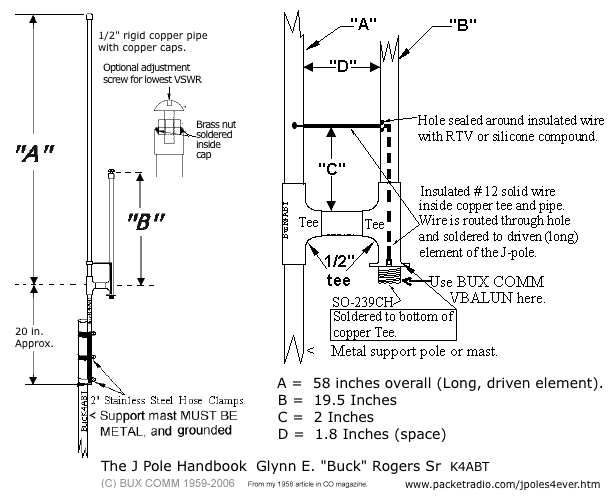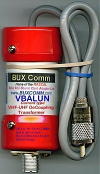 Hobbies
Hobbies
 Amateur Radio
Amateur Radio
 Antenna
Antenna
 J-Pole
Contact
J-Pole
Contact
Don's Home
 Hobbies
Hobbies
 Amateur Radio
Amateur Radio
 Antenna
Antenna
 J-Pole
Contact
J-Pole
Contact
|
Under Construction 
The J-Pole is a end-fed halfwave dipole. Sometimes referred to as a folded zepp. Zepps are 1/2 wavelength end-fed antennas, named after the German Zeppelin dirigibles where they were used.
The J pole antenna uses the stub to provide a good match to 50 Ohm cable. The feed point is moved up or down the stub to provide the best match, and adjustment can be made once the antenna is in position if required.
The following designs are for 2 meters, but it will listen well on 440.
  According to the J pole Handbook, A BUX VBALUN ($20) should be installed at the antenna feed point, or where the coax or feed-line attaches to the J-Pole antenna. BUX BALUNs are used to connect balanced antennas to unbalanced transmission lines, such as coax cable. Their primary purpose is to prevent antenna (RF) currents from flowing down the outside of the cable. Another function of the BUX BALUN41 is to match the impedance of an unbalanced coax to the balanced feed point of a balanced input antenna(s). BUX BALUNS may also be used as "line isolators" anywhere along the cable to prevent the destructive influence of induced RF currents (VSWR). BUX 1:1 BALUNs are current BALUNs. They consist of several large, number 73, ferrite type 44 cores. According to the J pole Handbook, A BUX VBALUN ($20) should be installed at the antenna feed point, or where the coax or feed-line attaches to the J-Pole antenna. BUX BALUNs are used to connect balanced antennas to unbalanced transmission lines, such as coax cable. Their primary purpose is to prevent antenna (RF) currents from flowing down the outside of the cable. Another function of the BUX BALUN41 is to match the impedance of an unbalanced coax to the balanced feed point of a balanced input antenna(s). BUX BALUNS may also be used as "line isolators" anywhere along the cable to prevent the destructive influence of induced RF currents (VSWR). BUX 1:1 BALUNs are current BALUNs. They consist of several large, number 73, ferrite type 44 cores.See: buxcomm.com/catalog/ Some guidelines in the J-Pole Tutorial from Gary E. O'Neil, (N3GO). Some are contrary to popular opinion.
Links: J pole Handbook Glynn E. "Buck" Rogers Sr., (K4ABT) at PacketRadio.com "The Copper Cactus J-Pole for 2m and 70 cm" (In spanish at qslbrasil.com), by John Post KE7AX, 73 Amateur Radio Today, Feb. 1992. Build a 2 Meter, 5/4 Wave Antenna using twin lead and PVC pipe. J-Pole Tutorial from Gary E. O'Neil, (N3GO) J Pole Antenna at Radio_electronics.com Copper J-Pole Antennas by dxzone.com J-Pole dimension calculator for different frequencies at mJw.com J-Pole Dimensions at N6mrx Dual band - Open stub by Chuck W4CLL J-Pole with 5/8 wave section above 1/2 wave Roll-uP J-Pole Antenna at the Conejo Valley Amateur Radio Club Another Roll-up Yet another roll-up
See Also: Return to Amateur Radion in Hobbies or Personal Radio in Products.
|